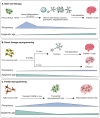Cell-based regenerative and rejuvenation strategies for treating neurodegenerative diseases
- PMID: 40189500
- PMCID: PMC11974143
- DOI: 10.1186/s13287-025-04285-7
Cell-based regenerative and rejuvenation strategies for treating neurodegenerative diseases
Abstract
Neurodegenerative diseases including Alzheimer's and Parkinson's disease are age-related disorders which severely impact quality of life and impose significant societal burdens. Cellular senescence is a critical factor in these disorders, contributing to their onset and progression by promoting permanent cell cycle arrest and reducing cellular function, affecting various types of cells in brain. Recent advancements in regenerative medicine have highlighted "R3" strategies-rejuvenation, regeneration, and replacement-as promising therapeutic approaches for neurodegeneration. This review aims to critically analyze the role of cellular senescence in neurodegenerative diseases and organizes therapeutic approaches within the R3 regenerative medicine paradigm. Specifically, we examine stem cell therapy, direct lineage reprogramming, and partial reprogramming in the context of R3, emphasizing how these interventions mitigate cellular senescence and counteracting aging-related neurodegeneration. Ultimately, this review seeks to provide insights into the complex interplay between cellular senescence and neurodegeneration while highlighting the promise of cell-based regenerative strategies to address these debilitating conditions.
Keywords: Cell-based therapy; Neurodegenerative diseases; Rejuvenation; Reprogramming; Senescence.
© 2025. The Author(s).
Conflict of interest statement
Declarations. Conflicts of interest: The authors declare no conflicts of interest.
Figures



References
-
- Thapa R, Ahmad Bhat A, Shahwan M, Ali H, PadmaPriya G, Bansal P, Rajotiya S, Barwal A, Siva Prasad GV, Pramanik A, Khan A, Hing Goh B, Dureja H, Kumar Singh S, Dua K, Gupta G. Proteostasis disruption and senescence in Alzheimer’s disease pathways to neurodegeneration. Brain Res. 2024;1845:149202. - PubMed
-
- de Magalhães JP. Cellular senescence in normal physiology. Science. 2024;384:1300–1. - PubMed
Publication types
MeSH terms
Grants and funding
LinkOut - more resources
Full Text Sources
Medical

